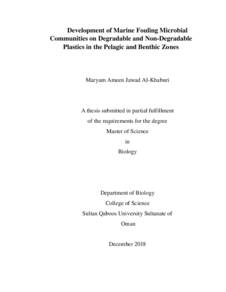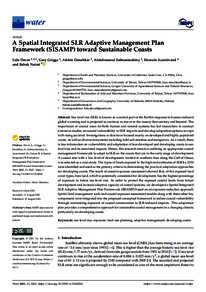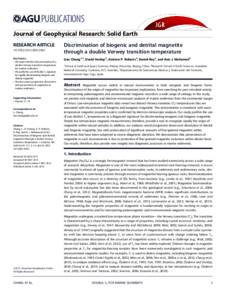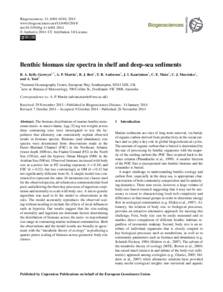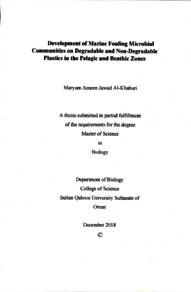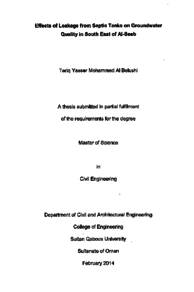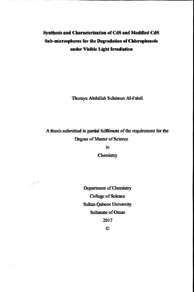Document
Development of marine fouling microbial communities on degradable and non-degradable plastics in the pelagic and benthic zones
Publisher
Sultan Qaboos University
Gregorian
2018
Language
English
Subject
English abstract
Marine biofouling is a process of accumulation of macro and microorganisms on a submerged surface in the marine environment. Marine biofouling form on many different surfaces and change their properties and characteristics. Plastic is one of the surfaces that is submerged in the marine environment and colonized by marine biofouling. Plastic pollution is a serious problem that affects our ecosystem. Most of the plastic waste is ended in the ocean causing hazardous effects on the marine environment, for example entanglement and suffocation of marine organisms, encountering persistent organic pollutants and leaching chemical additives from the plastic. In this study our aim was to investigate plastic associated microfouling communities on different types of plastic under temporal effect (after 20 and 80 days) in benthic and pelagic zones and to assess the degradation of plastics in the marine environment under abiotic and biotic factors. The study was held in the Marina Shangri La, Muscat, Oman. Three types of plastic were deployed, OXO biodegradable polyethylene (OXO-PE), Polyethylene (PE) and Polyethylene terephthalate (PET) at 2 m depth (pelagic) and 6 m depth (benthic) for 20 and 80 days. The accumulated biofouling was sampled and analyzed. Diatoms identification was done, and the microbial communities were characterized through next generation sequencing Miseq sequencing of 16S rRNA genes. In addition, the plastic substrates were analyzed for signs of degradation with scanning electron microscopy (SEM) and fourier-transform infrared spectroscopy (FTIR). The indicated results showed that biofouling communities are affected with time, substrate and depth. While the analysis of bacterial communities by non-metric multidimensional scaling NMDS showed that bacterial communities undergo distinct temporal shifts, whereas the three substrates showed similar communities with partial segregation. OXO-PE and PE showed high similarity in their bacterial communities while PET showed some differences in the bacterial community. Moreover, specific genera were found to favor certain plastic substrate more than the others due to the difference in the surface properties of the three plastics. Not much of a difference was detected between the pelagic and benthic zones in the bacterial communities. In terms of degradation all the three plastics showed signs of degradation after 20 days regardless of depth; however, PET showed less degradation in comparison with OXO-PE and PE. FTIR results showed formation of different bands of carbon and oxygen bonds in addition to hydroxyl bands which illustrated abiotic degradation; however, peaks of proteins and polysaccharides showed the contribution biotic degradation through microbes. Alteromonas and Haliea are examples of detected genera OXO-PE and PE that showed their ability to degrade hydrocarbons based on the previous studies. In conclusion, the different properties of plastic affects in the formation of marine biofouling communities. In addition, time is the most prominent factor that would change the microbial community structure. Finally, plastic are stable substrates especially PET, therefore they need very long time to degrade in water; however, microbes could potentially play a role and enhance plastic degradation.
Description
Thesis
Member of
Resource URL
Arabic abstract
التجمعات البحرية )الحشف البحري( تتكون على أي سطح مغمور بالماء. تتفاعل هذه التجمعات مع السطح وتقوم بتغيير خصائصه. من ضمن الأسطح التي يتجمع عليها الحشف البحري هو البلاستك ويعتبر البلاستك من أحد أكبر الملوثات البحرية حيث يؤدي الى اختناق الكثير من الكائنات البحرية، ويلوث المياه من خلال تسرب المواد الكيميائية المضافة في تصنيعه. في هذه الدراسة قمنا بالتركيز على تكون الحشف البحري على عدة أنواع من البلاستك في فترات زمنية مختلفة على أعماق مختلفة تحت الماء لمحاكاة البلاستك العائم على سطح الماء والبلاستك الغائص على سطح أرض البحر. تمت الدراسة في منتجع Shangri La بمسقط، سلطنة عمان. ثلاثة أنواع من البلاستك البولي ايثيلين (PE) والبولي ايثلين الحيوي (OXO-PE) والبولي ايثيلين تريفثاليت (PET) تم وضعها على عمق 2 م و 6 م تحت سطح الماء لمدة 20 و 80 يوما. قمنا بتحليل عينات الحشف البحري لمعرفة مجموعة البكتيريا المتكونة على سطح البلاستك في مختلف الظروف السابقة من خلال next generation sequencing Miseq sequencing of 16S rRNA genes . بالإضافة قمنا بتحليل عينات البلاستك المختلفة لمعرفة مدى تحلل البلاستك من خلال المجهر الالكتروني الماسح (SEM) ومقياس الطيف للأشعة تحت الحمراء
(FTIR) . أوضحت النتائج أن الحشف البحري يتأثر بعوامل الزمن، نوع البلاستك والعمق. بينما أوضح NMDS أن المجموعات البكتيرية تتغير بشكل جذري بمرور الزمن، في المقابل مقارنة المجموعات البكتيرية بين أنواع البلاستك
الثلاث وجد أن التشابه الأكبر بين المجموعات كان بين (OXO-PE) و (PE) بينما (PET) أظهر اختلافا بسيطا في المجموعات البكتيرية. بينما مقارنة المجموعات البكتيرية بين العمقين لم توضح الكثير من الاختلافات جميع أنواع البلاستك ظهرت عليها آثار التحلل بعد 20 يوما في كلا العمقين، ولكن الآثار ظهرت بشكل أقل على (PET) . FTIR أشار إلى ظهور روابط الكاربون والأكسجين بالإضافة إلى روابط مجموعة الهيدروكسيل مما أشار إلى تحلل البلاستك بسبب العوامل اللاأحيائية مثل أشعة الشمس والحرارة، وأيضا ظهرت مجموعة من الروابط التيتشير الى وجود البروتينات و السكريات المعقدة مما يشير إلى وجود عوامل التحلل البايولوجية مثل البكتيريا تعد Alteromonas و Haliea أمثلة على أنواع البكتيريا التي تم اكتشافها في هذه الدراسة والتي ذكرت فيما سبق أن لها القابلية على تحليل المواد الهيدروكاربونية.
البلاستك من أحد أكبر الملوثات في بيئتنا والتي تحتاج إلى وقت طويل للتحلل ولكن الكائنات الدقيقة قد تساهم في تحلل
البلاستك. بالإضافة إلى أن اختلاف أنواع البلاستك يؤثر في تكون الحشف البحري ولكن العامل الزمني له الأثر الأكبر
في ذلك.
(FTIR) . أوضحت النتائج أن الحشف البحري يتأثر بعوامل الزمن، نوع البلاستك والعمق. بينما أوضح NMDS أن المجموعات البكتيرية تتغير بشكل جذري بمرور الزمن، في المقابل مقارنة المجموعات البكتيرية بين أنواع البلاستك
الثلاث وجد أن التشابه الأكبر بين المجموعات كان بين (OXO-PE) و (PE) بينما (PET) أظهر اختلافا بسيطا في المجموعات البكتيرية. بينما مقارنة المجموعات البكتيرية بين العمقين لم توضح الكثير من الاختلافات جميع أنواع البلاستك ظهرت عليها آثار التحلل بعد 20 يوما في كلا العمقين، ولكن الآثار ظهرت بشكل أقل على (PET) . FTIR أشار إلى ظهور روابط الكاربون والأكسجين بالإضافة إلى روابط مجموعة الهيدروكسيل مما أشار إلى تحلل البلاستك بسبب العوامل اللاأحيائية مثل أشعة الشمس والحرارة، وأيضا ظهرت مجموعة من الروابط التيتشير الى وجود البروتينات و السكريات المعقدة مما يشير إلى وجود عوامل التحلل البايولوجية مثل البكتيريا تعد Alteromonas و Haliea أمثلة على أنواع البكتيريا التي تم اكتشافها في هذه الدراسة والتي ذكرت فيما سبق أن لها القابلية على تحليل المواد الهيدروكاربونية.
البلاستك من أحد أكبر الملوثات في بيئتنا والتي تحتاج إلى وقت طويل للتحلل ولكن الكائنات الدقيقة قد تساهم في تحلل
البلاستك. بالإضافة إلى أن اختلاف أنواع البلاستك يؤثر في تكون الحشف البحري ولكن العامل الزمني له الأثر الأكبر
في ذلك.
Category
Theses and Dissertations

